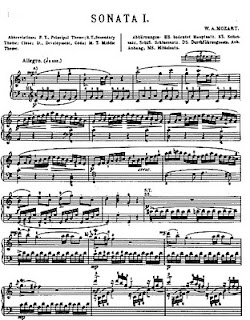Sonata.No. 16 in c major k.545 VBR MP3 Format 3.0 mb, Sonata.No. 16 in c major k.545 OGG format 2.8 mb which is a free, open standard container format maintained by the Xiph.Org Foundation. The OGG format is unrestricted by software patents and is designed to provide for efficient streaming and manipulation of high quality digital multimedia.
It is indeed difficult to believe that, at the age of only ten Mozart had written the Sonata Facile in C, which is one of his compositions included in this volume. I am sure that its delightfully melodious themes will please every lover of music,
The Piano Sonata No. 16 in C major, K. 545, by Wolfgang Amadeus Mozart was described by Mozart in his thematic catalogue as "for beginners," and it is sometimes known by the name Sonata facile or Sonata semplice.
Mozart added the work to his catalogue on June 26, 1788. The exact circumstances of the work's composition are not known. Although the piece is well known today it was not published in Mozart's lifetime, first appearing in print in 1805.
Composition Licence: This MP3 (or other media file) is in the public domain because its copyright has expired.This applies to the United States, where Works published prior to 1978 were copyright protected for a maximum of 75 years. See Circular 1 "COPYRIGHT BASICS" PDF from the U.S. Copyright Office. Works published before 1923 (in this case 1805) are now in the public domain.
This file is also in the public domain in countries that figure copyright from the date of death of the artist (post mortem auctoris), in this case Wolfgang Amadeus Mozart ((27 January 1756 – 5 December 1791), and that most commonly runs for a period of 50 to 70 years from December 31st of that year.
Performance Licence: This music is given a public domain license, therefore, there are no restrictions on what you do with it. Musopen asks, out of courtesy, two things. One, that you do not directly sell our recordings for profit. Two, we ask that any commerical or derived works attribute Musopen somewhere. And for all the film students, yes you may use it in your film, you can then sell the film, containing our music. It's in the public domain after all.
 | Sonata No. 16 In C Major, K.545 'Sonata Facile' Full Sheet Music in PDF Format. The permission for use of this work has been verified and archived in the Wikimedia OTRS system. It is available as ticket #2008012110017088 for users with an OTRS account. If you wish to reuse this work elsewhere, please read the instructions at COM:REUSE. If you are a Commons user and wish to confirm the permission, please contact someone with an OTRS account or leave a note at the OTRS noticeboard. |
This audio is part of the collection: Community Audio
Artist/Composer: Wolfgang Amadeus Mozart
Keywords: Wolfgang Amadeus Mozart
Creative Commons license: Public Domain Mark 1.0











